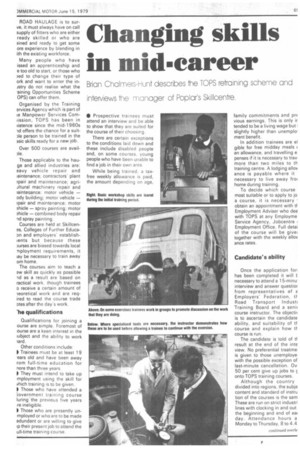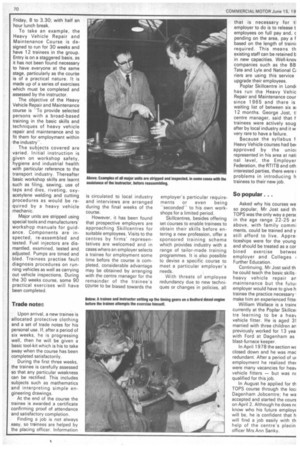Changing skills in mid-career
Page 71

Page 72

If you've noticed an error in this article please click here to report it so we can fix it.
Brian Chalmers-Hunt describes the TOPS retraining scheme and interviews e manager of Poplar's Skikentre,
ROAD HAULAGE is to surve, it must always have on call supply of fitters who are either ready skilled or who are ined and ready to get some ore experience by blending in ith the existing workforce.
Many people who have issed an apprenticeship and e too old to start, or those who ced to change their type of ork and want to enter the inJstry do not realise what the .aining Opportunities Scheme .OPS) can offer them.
Organised by the Training ervices Agency which is part of ie Manpower Services Corniission, TOPS has been in cistence since the mid-1960s id offers the chance for a suit31e person to be trained in the asic skills ready for a new job.
Over 500 courses are avail)1e.
Those applicable to the hauge and allied industries are: eavy vehicle repair and iaintenance; contractors plant ;pair and maintenance; agridltural machinery repair and rainteaance; motor vehicle — ody building; motor vehicle — pair and maintenance; motor chicle — spray painting; motor chicle — combined body repair nd spray painting.
Courses are held at SkilIcenes, Colleges of Further Educaon and employers' establishlents but because these )urses are biased towards local mployment requirements, it iay be necessary to train away om home.
The courses aim to teach a ew skill as quickly as possible ad as a result are based on ractical work, though trainees o receive a certain amount of leoretical work and are reqired to read the course trade otes after the day's work.
he qualifications
Qualifications for joining a :ourse are simple. Foremost of ,ourse are a keen interest in the lubject and the ability to work lard.
Other conditions include:
I Trainees must be at least 19 ,ears old and have been away rem full-time education for fore than three years.
I They must intend to take up irnployment using the skill for yhich training is to be given.
I Those who have attended a ;overnment training course luring the previous five years ire ineligible.
Those who are presently unmployed or who are to be made eclundant or are willing to give ip their present job to attend the ull-time training course.
• Prospective trainees must attend an interview and be able to show that they are suited for the course of their choosing.
There are certain exceptions to the conditions laid down and these include disabled people and, on some courses, young people who have been unable to find a job in their own area.
While being trained, a taxfree weekly allowance is paid, the amount depending on age, family commitments and pr( vious earnings. This is only ir tended tobe a living wage but slightly higher than unemplo ment benefit.
In addition trainees are el gible for free midday meals an allowance, and travelling e penses if it is necessary to tray more than two miles to th training centre. A lodging alloy ance is payable where it necessary to live away froi home during training.
To decide which course most suitable or to apply to jo a course, it is necessary obtain an appointment with ti Employment Adviser who dea with TOPS at any Employme Service Agency, Jobcentre Employment Office. Full detai of the course will be give, together with the weekly alloy rice rates.
Candidate's ability Once the application for has been completed it will I: necessary to attend a 1 5-minu interview and answer questior from representatives of a Employers' Federation, th Road Transport Indust' 'Training Board and a senii course instructor. The objectil is to ascertain the candidate ability, and suitability of a course and explain how tt course is run.
The candidate is told of 'a result at the end of the int€ view. No preferential treatrne is given to those unemployel with the possible exception of last-minute cancellation. Ov 50 per cent give up jobs to c. onto TOPS training courses.
Although the country divided into regions, the subje content and standard of instru tion of the courses is the sam These are run on strict industr, lines with clocking in and out the beginning and end of eel day. Attendance hours a Monday to Thursday, 8 to 4.4 Friday, 8 to 3.30; with half an hour lunch break.
To take an example, the Heavy Vehicle Repair and Maintenance Course is designed to run for 30 weeks and have 12 trainees in the group. Entry is on a staggered basis, as it has not been found necessary to have everyone at the same stage, particularly as the course is of a practical nature. It is made up of a series of exercises which must be completed and assessed by the instructor.
The objective of the Heavy Vehicle Repair and Maintenance course is "To provide selected persons with a broad-based training in the basic skills and techniques of heavy vehicle repair and maintenance and to fit them for employment within the industry".
The subjects covered are varied. Initial instruction is given on workshop safety, hygiene and industrial health with particular reference to the transport industry. Thereafter basic workshop skills are learnt such as filing, sawing, use of taps and dies, riveting, oxyacetylene welding and cutting procedures as would be required by a heavy vehicle mechanic.
Major units are stripped using special tools and manufacturers' workshop manuals for guidance. Components are inspected, re-assembled and tested. Fuel injectors are dismantled, examined, tested and adjusted. Pumps are timed and bled. Trainees practise fault diagnosis procedures on running vehicles as well as carrying out vehicle inspections. During the 30 weeks course, some 90 practical exercises will have been completed.
Trade notes
Upon arrival, a new trainee is allocated protective clothing and a set of trade notes for his personal use. If. after a period of six weeks, he is progressing well, then he will be given a basic tool-kit which is his to take away when the course has been completed satisfactorily.
During the first three weeks, the trainee is carefully assessed so that any particular weakness can be rectified. This includes subjects such as mathematics and interpreting simple engineering drawings.
At the end of the course the trainee is awarded a certificate confirming proof of attendance and satisfactory completion.
Finding a job is not always easy, so trainees are helped by the placing officer. Information is circulated to local industry and interviews are arranged during the final weeks of the course.
However, it has been found that prospective employers are approaching Skillcentres for suitable employees. Visits to the centres by firms' representatives are welcomed and in cases where an employer selects a trainee for employment some time before the course is completed, considerable advantage may be obtained by arranging with the centre manager for the remainder of the trainee's course to be biased towards the
employer's particular requirements or even being -seconded" to his own workshops for a limited period.
Skillcentres, besides offering set courses to enable trainees to obtain their skills before entering a new profession, offer a sponsored training scheme which provides industry with a range of tailor-made training programmes. It is also possible to devise a specific course to meet a particular employer's needs.
With threats of employee redundancy due to new techniques or changes in policies, all that is necessary for tl employer to do is to release t employees on full pay and, c pending on the area, pay a f based on the length of trainii required. This means th existing staff can be retained b in new capacities. Well-knov companies such as the BB Tate and Lyle and National Ci riers are using this service upgrade their employees.
Poplar Skillcentre in bond+ has run the Heavy Vehic Repair and Maintenance cour since 1965 and there is waiting list of between six al 12 months. George Jost, t centre manager, said that 1trainees were actively soug after by local industry and it w very rare to have a failure.
Because the syllabus f Heavy Vehicle courses had bei approved by the unioi represented in his area at nati nal level, the Employer Federation, the -RTITB and oth interested parties, there were problems in introducing h trainees to their new job.
So popular. .
Asked why his courses we so popular, Mr Jost said th TOPS was the only way a pers( in the age range 22-25 ar above, with family comm ments, could be trained and y still afford to live. Appre ticeships were for the young and should be treated as a cor bined exercise betweE employer and Colleges Further Education.
Continuing, Mr Jost said th he could teach the basic skills heavy vehicle repair ar maintenance but the futui employer would have to give h trainee the practice necessary make him an experienced fitte William Wallace is a train( currently at the Poplar SkilIcel tre learning to be a hea% vehicle fitter. He is aged 3! married with three children ar previously worked for 13 yea with Ford at Dagenham as blast-furnace keeper.
In April 1978 the section WE closed down and he was mac redundant. After a period of ui employment he realized the' were many vacancies for heav vehicle fitters — but was nc qualified for this job.
In August he applied for th TOPS course through the loch Dagenham Jobcentre; he wa accepted and started the cours on April 2. Although he does n( know who his future employ( will be, he is confident that h will find a job easily with th help of the centre's placin officer Mrs Ann Sanky.




























































































































